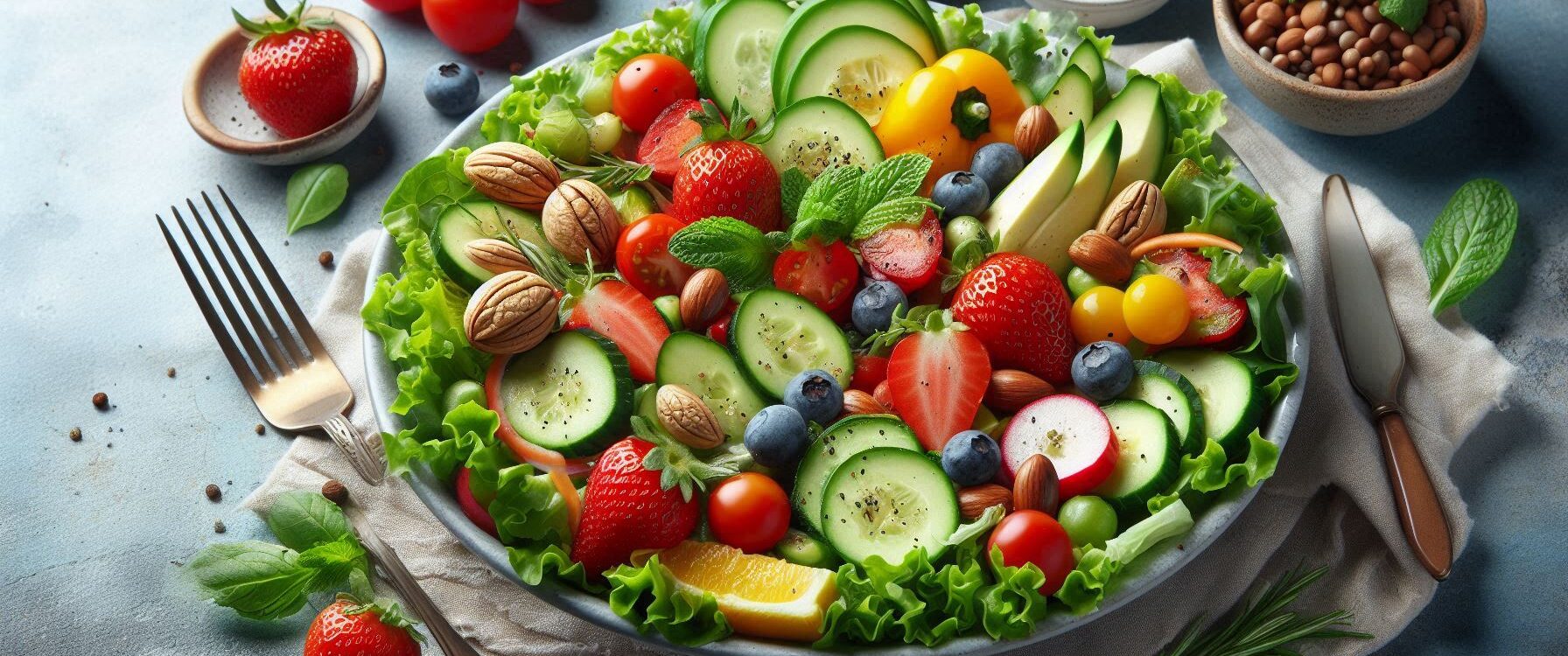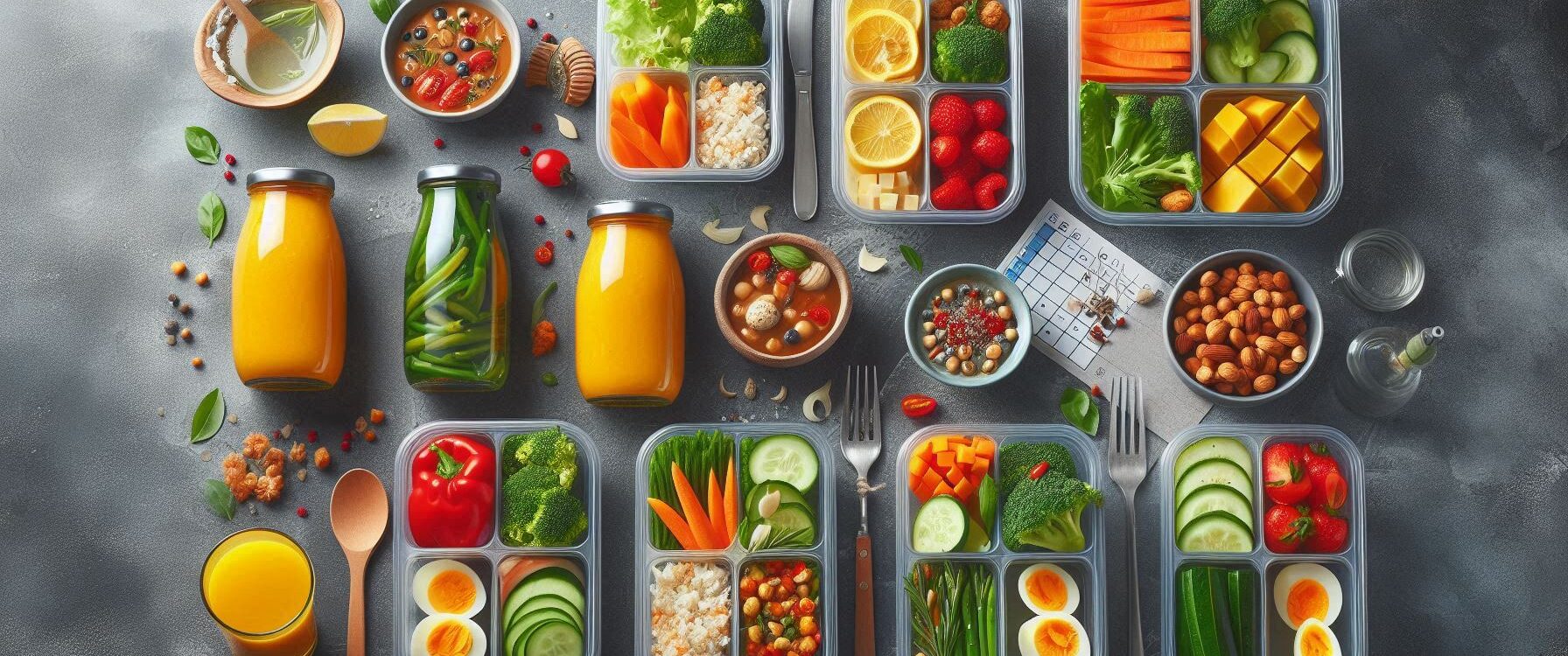Top Takeaways and Key Concepts
Build balanced meals with carbs, protein, and healthy fats to fuel your body daily.
Track your eating habits to discover foods that boost energy and reduce cravings.
Meal prep weekly to avoid unhealthy choices and stay consistent with your diet.
Control portions by using smaller plates and mindful serving sizes to prevent overeating.
Add variety and listen to your body to enjoy food while supporting long-term weight loss.
Summary of This Article
Please Note: This post may contain affiliate links. If you click one of them, we may receive a commission at no extra cost to you. As an Amazon Associate, I earn from qualifying purchases.
This article explains how to create a balanced, realistic, and enjoyable diet plan for better health and fat loss. It emphasizes including all major nutrients—carbs, proteins, and healthy fats—in meals rather than restricting entire food groups. By tracking eating habits, meal prepping, and practicing portion control, you can make smarter choices and avoid overeating. The article also highlights the importance of trying new foods, enjoying treats in moderation, and listening to your body’s hunger signals. With community support and a flexible approach, building a healthy diet can be sustainable and fun.

Building a balanced diet plan for better health and fat loss sounds like a serious task, doesn’t it? I mean, you might picture yourself standing in the grocery store aisle, staring at kale like it just insulted your mother. But fear not! Crafting a diet plan that’s as enjoyable as it is effective can be done without sacrificing all the good stuff—like pizza and chocolate. Yes, you heard me right!
Understanding What “Balanced” Means

Eating a balanced diet is like being in a relationship with food—too much of one thing can lead to drama, while the right mix keeps everything harmonious. Just remember: if your plate looks like a rainbow, you’re probably doing it right!
“To me, dieting is just another word for ‘I’m not allowed to eat that'.” — Oprah Winfrey
Let’s kick things off by defining what a balanced diet actually looks like. In my mind, it’s like trying to keep an unruly group of kids in line at a birthday party—everyone needs their fair share of cake (or nutrients), but too much of one thing will end up with someone crying in the corner.

A balanced diet includes carbohydrates, proteins, fats, vitamins, and minerals, each playing a crucial role in keeping your body functioning optimally.
– Carbohydrates: Think of carbs as your energetic friends who keep the party lively. They’re like that friend who always brings the best snacks to gatherings—hello, pasta! Carbs provide your body with quick energy for daily activities and workouts. Whether it’s whole grains, fruits, or starchy vegetables, these foods fuel your brain and muscles, ensuring you have the stamina to tackle whatever comes your way.
– Proteins: Now let’s talk about proteins—the reliable buddies who help build muscle and repair tissues. Thank you chicken breast! Proteins are essential for growth and maintenance of every cell in your body. They help create enzymes and hormones while also supporting immune function. Sources like lean meats, fish, eggs, legumes, and dairy products are packed with protein power that keeps you feeling strong and satisfied.
– Healthy Fats: And then there are healthy fats—the quiet ones in the back who still know how to bring deliciousness into the mix. Avocados anyone? These unsung heroes play a vital role in nutrient absorption and hormone production while providing long-lasting energy. Healthy fats found in nuts, seeds, olive oil, and fatty fish not only enhance flavor but also contribute to heart health by reducing inflammation.
In addition to these macronutrients (carbs, proteins, fats), don’t forget about vitamins and minerals, which act as the support crew behind the scenes. They help convert food into energy and strengthen bones among many other functions. A colorful variety of fruits and vegetables can ensure you're getting a broad spectrum of these essential nutrients.
Some Fun Balanced Health Ideas
– Veggie Vibes: Did you know that eating a rainbow of vegetables not only looks pretty on your plate but also gives you the chance to tell people you're “eating the whole color wheel”? Just don’t try to paint with them!
– Snack Attack: Research shows that if you eat snacks while standing up, they have zero calories. Okay, maybe not zero, but it sure feels like it when you're multitasking and dancing in the kitchen!
– Mindful Munching: Studies suggest that if you eat while watching TV, you'll consume about 50% more snacks. So unless your goal is to become one with the couch, consider turning off those binge-worthy shows during snack time!
So remember: when you think about your meals, aim for balance! Each component has its unique personality that contributes to a vibrant health party within your body. Embrace them all for a well-rounded approach to nutrition that supports overall wellness!
Finding Your Personal Balance

Did you know that some people actually eat dessert first? It’s called “eating like a kid,” and research suggests that allowing yourself a treat can help you stick to healthier choices later. So go ahead, have that slice of cake—it might just keep you from raiding the cookie jar later!
“I’m on the patch right now. I’m trying to get off sugar.” — Adele
Now that we’ve established what balance means let’s dive into how to find your personal sweet spot. Honestly, this part feels a bit like dating; you’ll need to experiment before finding what truly makes your taste buds sing.
Start by keeping track of what you eat for a week. Sounds tedious? It might be—but think of it as detective work! You’re gathering evidence on which foods make you feel fantastic and which ones leave you feeling sluggish or bloated. This process is akin to being your own health investigator, uncovering clues about how different foods impact your energy levels, mood, and overall well-being.
Fun Facts for Finding Your Personal Balance
– Plate Size Shenanigans: Using smaller plates can trick your brain into thinking you're eating more. It’s like giving your food a funhouse mirror effect—everything looks bigger and more satisfying!
– Chocolate Therapy: Eating dark chocolate in moderation may actually help reduce cravings for sweets. So, go ahead and call it “self-care” when you indulge—it’s practically a health investment!
– Laugh It Off: Did you know that laughing for just 10 to 15 minutes can burn about 40 calories? So next time you feel guilty about dessert, just watch a funny movie—it's basically a workout!
As you embark on this culinary investigation, take note of everything that crosses your plate—meals, snacks, beverages—even those sneaky bites taken while cooking! Use a notebook or an app to jot down not only what you eat but also how each food makes you feel afterward. Did that mid-afternoon donut give you a sugar rush followed by a crash? Or did that quinoa salad keep you energized throughout the day? This self-awareness will provide invaluable insights into your eating habits.
Once you've gathered that intel, it's time to analyze the data. Look for patterns: Are there certain foods that consistently make you feel good? Perhaps fruits and vegetables boost your mood and energy levels, while processed snacks leave you feeling heavy. With this knowledge in hand, start swapping out less nutritious options for healthier choices while still enjoying some of your favorites.

For example, if you love pasta but find it leaves you feeling sluggish, consider switching to whole grain or legume-based pasta for added fiber and nutrients without sacrificing taste. If chips are your guilty pleasure during movie night, try air-popped popcorn seasoned with herbs instead—it’s light and can satisfy that crunch craving!
The key here is moderation and balance; allow yourself to indulge occasionally without guilt while making smarter choices most of the time. This way, you're not depriving yourself but rather enhancing your diet with more nourishing options that support your goals.
Remember, this journey isn't just about eliminating foods; it's about discovering new flavors and combinations that excite your palate while promoting better health. By treating this experience as an adventure in nutrition rather than a chore, you'll find it easier to stick with these changes long-term. Happy tracking!
Meal Prep: Your New Best Friend

A study found that people who meal prep tend to eat 1.5 times more vegetables than those who don’t, which means your fridge might just become the most colorful place in your home—who knew broccoli could be so trendy?
“To me, food is as much about the moment as it is about the taste.” — Gordon Ramsay
Speaking of favorites, meal prep is where the magic happens! Imagine opening your fridge only to see perfectly portioned meals lined up like soldiers ready for battle against hunger. It’s glorious! By preparing meals ahead of time, you're setting yourself up for success—no more last-minute decisions leading to takeout pizza or questionable late-night snacks.
I remember when I first tried meal prepping; I felt like I was auditioning for MasterChef. My kitchen became my culinary playground! Armed with colorful produce, a sharp knife, and an array of spices, I transformed my cooking space into a bustling studio. I roasted veggies while blasting my favorite tunes, dancing around the kitchen as if I were on stage, and feeling like a true culinary artist. The sizzle of vegetables hitting the hot pan was music to my ears, and each chop of the knife felt like a confident stroke of genius.
Fun Facts About Meal Prep: Your New Best Friend
– Freezer Tetris: Meal prepping can turn your freezer into a game of Tetris! The more you prep, the better you get at fitting in those containers—just don’t forget to label them or you might end up with a surprise mystery meal!
– Chop It Like It's Hot: Studies show that spending just 30 minutes chopping veggies can make you feel like a culinary ninja. Plus, it’s way cheaper than therapy for when you're feeling overwhelmed by life!
– The Spice is Right: Adding spices not only boosts flavor but can also speed up metabolism. So sprinkle on that cayenne pepper and call it “performance-enhancing seasoning”—it’s like giving your meals a little pep talk!
As I meticulously arranged everything—bright bell peppers, deep green kale, and golden sweet potatoes—I marveled at how vibrant and inviting my meals looked. Gone were the days of mindlessly reaching for stale chips from the back of my pantry; now, every time I opened that Tupperware container filled with colorful food, it was like unveiling a masterpiece. Each portion was not just a meal but a celebration of flavors and nutrients that promised to fuel my body rather than weigh it down.
The satisfaction didn’t stop there; it extended to knowing exactly what I was eating throughout the week. No more last-minute takeout or unhealthy snacking! Instead, I had delicious homemade options ready to go whenever hunger struck. Meal prepping became not only about saving time but also about nurturing myself in a way that felt rewarding.

I experimented with different recipes and flavor combinations, turning simple ingredients into exciting dishes. One day it might be spicy roasted chickpeas paired with quinoa and steamed broccoli; another day could feature zesty lemon herb chicken alongside a colorful medley of roasted root vegetables. The possibilities were endless!
And let’s not forget the joy of sharing this newfound passion with friends—inviting them over for meal prep sessions turned into fun gatherings where we swapped tips, tasted each other’s creations, and laughed over our culinary mishaps (because yes, sometimes things did get messy).
Meal prepping transformed from being merely an organizational task into an enjoyable ritual that empowered me to take control of my health while exploring new flavors in the process. It made healthy eating feel less like a chore and more like an adventure—a delicious one at that! So, here’s to all those aspiring chefs out there: put on your apron, crank up your playlist, and let your kitchen become your canvas!
Portion Control: The Art of Moderation

Eating off a smaller plate can trick your brain into thinking you're consuming more food, which is great until you realize you just served yourself a single grape on a dinner plate and called it a meal!
“I’m not trying to be skinny. I’m just trying to be healthy.” — Kelly Osbourne
Ah yes, portion control—the fine art of eating just enough without overdoing it. This can be tricky because let’s face it: our eyes often have bigger appetites than our stomachs do. Who hasn’t polished off an entire bag of popcorn during movie night only to regret it halfway through?
To combat this sneaky phenomenon of overeating, try using smaller plates or bowls. It sounds silly, but honestly, it works wonders! The psychology behind it is fascinating—when you serve your food on a smaller plate, it creates the illusion of a full meal. Your brain sees that colorful array of food filling up the plate and sends signals to your body that you’re indulging in a satisfying feast, even if the portion size is actually smaller than what you'd normally eat.
Fun Insights on Portion Control: The Art of Moderation
– Plate Size Matters: Using a smaller plate can trick your brain into thinking you’re eating more. It’s like magic—now you can tell your friends you’re “portion controlling” while actually enjoying a full plate of pasta!
– The One-Bite Rule: Did you know that taking one bite of dessert can satisfy your sweet tooth? Just remember, if someone offers you a second bite, it’s perfectly acceptable to say, “I’m practicing portion control… for science!”
– Visualize Your Portions: Studies show that people eat less when they visualize their portions. So next time you're at a buffet, just imagine each dish is an Olympic event—only gold medal servings for you!
Imagine sitting down to a meal with a petite plate piled high with vibrant veggies, lean proteins, and whole grains. It looks abundant and inviting! You take that first bite and savor the flavors while your mind registers that delightful visual of fullness. This simple trick can help curb those pesky cravings for seconds or thirds because, psychologically speaking, you've already tricked yourself into feeling satisfied.
Plus, nobody wants to waste food; that would just lead us down an emotional spiral involving guilt over wasted calories. Think about it: how often have you finished a meal only to feel like you’ve overindulged? Using smaller dishes not only helps control portions but also reduces the likelihood of leftovers going uneaten in the fridge. No more half-eaten meals languishing in Tupperware as reminders of our overeating habits!
And let’s be honest—who doesn’t want to feel good about their eating choices? By reducing portion sizes without sacrificing satisfaction, we empower ourselves to enjoy our favorite foods guilt-free. You get to relish every bite without worrying about spiraling into regret later on.
In addition to using smaller plates, consider embracing fun serving styles! Try stacking mini burgers or creating bite-sized versions of your favorite dishes. Not only does this make mealtime more enjoyable and playful, but it also allows for variety without overwhelming your plate—or your stomach!
So next time you're preparing for a meal, grab those cute little plates hiding at the back of your cupboard and watch as they work their magic! You’ll find yourself enjoying delicious meals while still staying mindful of portion sizes—an easy way to maintain balance without feeling deprived. After all, who knew such a small change could lead to big results?
Incorporating Variety Is Key

Eating a variety of foods can actually make you happier—so if you're feeling down, just remember that trying to find out how many different ways you can eat broccoli is a legitimate mood booster!
“I think the biggest thing is to not be so hard on yourself. It’s okay to have pizza and donuts.” — Chrissy Teigen
Another crucial element in creating a balanced diet plan is variety—because no one wants to live on chicken breast and broccoli forever unless they’re secretly training for a bodybuilding competition or plotting world domination through dietary monotony.
Experiment with different cuisines! Trying out a variety of culinary traditions can transform your meal planning from mundane to magnificent. Imagine diving into the rich, aromatic world of Indian curries one night, where spices like cumin and turmeric dance together in a symphony of flavor, followed by a vibrant taco fiesta the next evening, complete with zesty salsa and fresh guacamole. Your taste buds will thank you later for this delightful adventure!
Fun Facts About Incorporating Variety in Your Diet
– Taste Buds Love Adventure: Eating a variety of foods can keep your taste buds excited! If they had social media, they’d definitely be posting about their “foodie adventures” instead of just scrolling through the same old broccoli pics.
– Colorful Plates Equal Happy Plates: A diverse diet means more colors on your plate! Think of it as a health-conscious rainbow—who knew you could eat like a unicorn and still lose weight?
– Switch It Up for Weight Loss: Research suggests that varying your meals can help prevent boredom and cravings. So if you’re tired of chicken, try swapping it for tofu or even… wait for it… dessert-flavored protein shakes! (Just kidding… maybe.)
Exploring new recipes opens up a treasure trove of flavors and textures that can reignite your passion for healthy eating. Instead of dreading another bland meal or falling into the same repetitive cycle of chicken and broccoli, you’ll find yourself excitedly flipping through cookbooks or scrolling through food blogs in search of inspiration. The joy of cooking becomes an exploration rather than a chore.
Consider trying Thai dishes that burst with fresh herbs and zesty lime, or Mediterranean meals featuring colorful salads drizzled with olive oil and sprinkled with feta cheese. Each cuisine offers its own unique approach to nutrition while also allowing you to indulge in delicious flavors without sacrificing health. By incorporating these diverse ingredients, you not only enhance your palate but also ensure you're getting a wide range of nutrients.
Plus, experimenting with international recipes can turn mealtime into an event! Invite friends over for a themed dinner night where everyone brings their favorite dish from around the globe. Not only does this foster community and connection over shared meals, but it also encourages creativity in the kitchen as you learn new cooking techniques and flavor combinations.
And let’s not forget about the fun factor—cooking should be enjoyable! When you're excited about what you're making, it’s much easier to stick to healthier choices. You might discover that preparing homemade sushi is not only entertaining but also allows you to control what goes into your rolls—hello, nutritious fillings!
So go ahead—grab those spices you've never used before or attempt that complex recipe you've been eyeing online. Embrace the challenge! You’ll likely find that adding variety to your meals makes healthy eating feel less like a diet and more like an exciting culinary journey. Who knew maintaining good health could be such a flavorful experience? Your body—and your taste buds—will reap the rewards!
Listening To Your Body

If you listen closely, your body might just tell you it wants pizza for breakfast, tacos for lunch, and dessert for dinner—it's like a culinary DJ spinning your favorite tracks! Just remember to read the fine print: moderation is key!
“Take care of your body. It's the only place you have to live.” — Jim Rohn
This next tip may sound cliché but bear with me: listen to your body! We often forget that our bodies communicate with us more than we realize; they send signals when they're hungry or full if only we’d pay attention.
When starting any new diet plan—or really any life change—it’s crucial to shift your focus beyond just the numbers on a scale or calorie counts. Instead, pay attention to how different foods impact your physical and mental well-being throughout each day. After all, food is not merely fuel; it can significantly influence your mood, energy levels, and overall health.
Fun Insights on Listening to Your Body
– The Snack Alarm: Your body has a built-in snack alarm that goes off every time you’re within ten feet of a vending machine. It’s like your stomach is secretly training for the Olympics in snack retrieval!
– Hunger vs. Boredom: Sometimes, your body just wants attention! If you find yourself craving chips while binge-watching your favorite show, it might be boredom trying to trick you into a snack attack.
– The “Just One More” Syndrome: Ever notice how your body can suddenly forget its limits when dessert is involved? It's like it transforms into an overenthusiastic party guest who insists on having “just one more” slice of cake—every single time!
For instance, after enjoying a hearty meal, take note of how you feel in the hours that follow. If a particular dish leaves you feeling sluggish or bloated—like that heavy pasta dinner followed by an afternoon slump—it might be time to reconsider its place on your plate. Recognizing these patterns is key to making informed choices about what to eat.
On the flip side, think about those meals that leave you energized and satisfied! Maybe it’s a colorful salad topped with lean protein or a vibrant stir-fry filled with fresh vegetables. When you find foods that make you feel great—both physically and mentally—you're more likely to incorporate them into your routine consistently.
This mindful approach encourages you to become more attuned to your body's signals. Rather than simply adhering to strict dietary rules or trends that may not suit your lifestyle, this method allows for flexibility and personalization in your eating habits. It empowers you to experiment with different ingredients and meal combinations while listening closely to what works best for you.
Additionally, consider keeping a food journal where you jot down not only what you've eaten but also how each meal made you feel afterward. Over time, this practice can reveal valuable insights into which foods are truly nourishing versus those that might cause discomfort or fatigue. You'll start recognizing the unique relationship between certain foods and your body’s responses.
Moreover, remember that mental wellness is equally as important as physical health when it comes to dieting. Foods rich in nutrients can positively affect our mood and cognitive function; think of omega-3 fatty acids found in fish or antioxidants from berries that boost brain health! So, indulging in wholesome options doesn’t just benefit your waistline—it can enhance clarity and happiness too.
In summary, embracing this holistic perspective fosters a healthier relationship with food by promoting self-awareness rather than restriction. By prioritizing how various foods make us feel throughout the day—both physically and mentally—we set ourselves up for sustainable success on our journey toward better health. This way of thinking helps ensure we enjoy our meals while fueling our bodies effectively, ultimately leading us toward long-term well-being rather than temporary fixes!
Staying Motivated Through Community Support
Finally—and perhaps most importantly—don’t go at this alone! Find support from friends or family members who share similar goals; having accountability partners makes everything easier and more fun! After all, sharing victories (and maybe even failures) strengthens bonds among loved ones while keeping everyone motivated along their journey together.
So, whether you're cheering each other on during workouts or trading healthy snack ideas via text message—it helps create an environment conducive not only towards achieving weight loss goals but also fostering overall well-being!
By now you should have plenty of inspiration for building that balanced diet plan designed specifically for better health—and trust me when I say achieving fat loss doesn’t have to feel like climbing Mount Everest barefoot!
Here are some resources if you'd like further reading:
Healthy Eating Tips
https://www.choosemyplate.gov/eathealthy/healthyeatingtips
Portion Control Guide
https://www.eatright.org/health/lifestyle/culture-and-traditions/portion-control-guide
Meal Prep 101
https://www.mealpreponfleek.com/
Frequently Asked Questions
What does a balanced diet plan include?
A balanced diet includes carbohydrates, proteins, healthy fats, vitamins, and minerals that work together to support energy, strength, and overall health.
How do I start building a balanced diet for fat loss?
Begin by planning meals that combine lean proteins, whole grains, and healthy fats while practicing portion control and eating mindfully.
Why is meal prepping important for a healthy diet?
Meal prepping saves time, helps avoid unhealthy food choices, and ensures you always have nutritious, portioned meals ready to enjoy.
What role does portion control play in weight loss?
Portion control prevents overeating by helping you enjoy your favorite foods in moderation while maintaining a calorie balance for fat loss.
How can I add variety to my diet without losing progress?
Experiment with new cuisines, colorful fruits and vegetables, and healthy swaps to keep meals exciting while meeting nutritional goals.
Why is it important to listen to your body while dieting?
Listening to your body helps you recognize true hunger and fullness cues, making it easier to eat mindfully and maintain sustainable habits.
How can community support help with healthy eating goals?
Having friends or family with similar goals offers motivation, accountability, and encouragement to stay consistent with your diet plan.

Kevin Collier is a passionate health writer specializing in fat loss, weight loss strategies, and effective dieting techniques. With an emphasis on evidence-based approaches, he aims to provide readers with actionable insights that simplify the journey to achieving their weight loss goals. At TapFat.com, Kevin shares practical advice, tips, and motivational content to empower individuals to make informed choices about their diet and lifestyle. His mission is to support others in their pursuit of a healthier, fitter self, demystifying the weight loss process and celebrating each step toward success.




